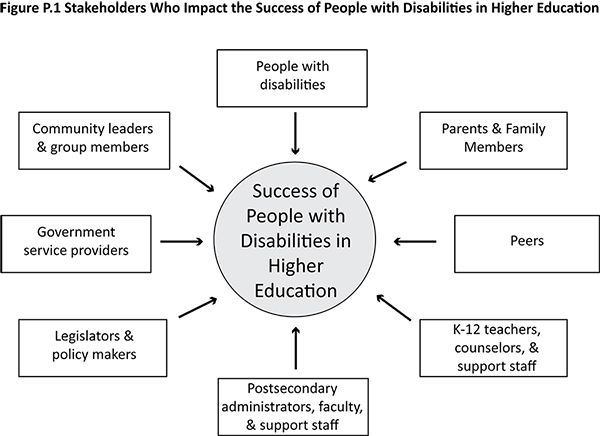The Importance of Community
"I learned to be determined and never give up, and, with the help I need, I can take take on anything" - Fred
Success rarely happens in isolation. Student success is impacted by many stakeholders, as illustrated in Figure P.1—people with disabilities themselves; parents and family members; peers; K-12 teachers, counselors, and support staff; postsecondary administrators, faculty, and staff; legislators and policy makers; government service providers; and community leaders and group members. The Disabilities, Opportunities, Internetworking, and Technology (DO-IT) Center at the University of Washington, with funding from federal, state, and private sources, has addressed issues in most of these areas with projects, publications, and web resources described at www.uw.edu/doit.
Specifically, in AccessSTEM, AccessComputing, and other programs led by DO-IT, mentor, peer, and near-peer support occurs both in person and within an e-mentoring community. Participants are mentored within a group, thus many contribute to conversations. Participants also disseminate academic- and career-enhancing resources that benefit all community members. Benefits of the e-community approach may include the following:
- Individuals benefit from the experiences of a large group of mentors, peers, and near-peers.
- Mentors can specialize in areas of greatest strength.
- Mentors learn techniques from each other by attending to the communications that take place.
- The program performs successfully even though some mentors are less available and skilled than others.
- Using asynchronous, text-based communication on the Internet eliminates barriers posed by other forms of communication with respect to location, schedule, and disability.
- Program administrators view all group communications that take place, thus making it possible for them to guide and contribute to conversations.
Most AccessSTEM and AccessComputing mentors are college students, faculty, engineers, scientists, or other professionals who have disabilities. Mentees are pursuing STEM careers, and they all have disabilities, including vision, hearing, mobility, health impairments and specific learning disabilities. Frequent electronic communications and personal contacts bring mentees, peers, near-peers, and mentors together to facilitate academic, career, and personal achievements.
DO-IT’s mentoring program received national recognition when it received the 1997 Presidential Award for Excellence in Mentoring “for embodying excellence in mentoring underrepresented students and encouraging their significant achievement in science, mathematics, and engineering.” It also received the National Information Infrastructure Award in 1995 “for those whose achievements demonstrate what is possible when the powerful forces of human creativity and technologies are combined.” Research results suggest the success of the DO-IT electronic community in promoting positive college and career outcomes. But more importantly, the DO-IT e-mentoring community has documented its value in the successful lives of its participants and the willingness of those who were once protégés to support young people in the community as they were supported in their youth.
In the following section of this book, students share stories about the importance of community and the influence of supportive individuals in their pursuit of STEM careers.
